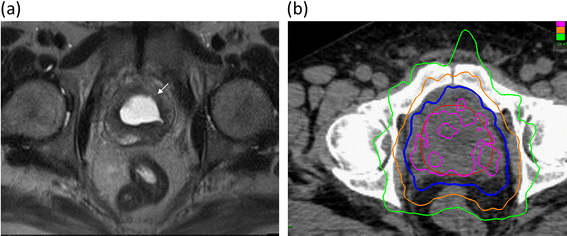Hematuria following stereotactic body radiation therapy (SBRT) for clinically localized prostate cancer
- PMID: 25890265
- PMCID: PMC4358866
- DOI: 10.1186/s13014-015-0351-6
Hematuria following stereotactic body radiation therapy (SBRT) for clinically localized prostate cancer
Abstract
Background: Hematuria following prostate radiotherapy is a known toxicity that may adversely affect a patient's quality of life. Given the higher dose of radiation per fraction using stereotactic body radiation therapy (SBRT) there is concern that post-SBRT hematuria would be more common than with alternative radiation therapy approaches. Herein, we describe the incidence and severity of hematuria following stereotactic body radiation therapy (SBRT) for prostate cancer at our institution.
Methods: Two hundred and eight consecutive patients with prostate cancer treated with SBRT monotherapy with at least three years of follow-up were included in this retrospective analysis. Treatment was delivered using the CyberKnife® (Accuray) to doses of 35-36.25 Gy in 5 fractions. Toxicities were scored using the CTCAE v.4. Hematuria was counted at the highest grade it occurred in the acute and late setting for each patient. Cystoscopy findings were retrospectively reviewed. Univariate and multivariate analyses were performed. Hematuria-associated bother was assessed via the Expanded Prostate Index Composite (EPIC)-26.
Results: The median age was 69 years with a median prostate volume of 39 cc. With a median follow-up of 48 months, 38 patients (18.3%) experienced at least one episode of hematuria. Median time to hematuria was 13.5 months. In the late period, there were three grade 3 events and five grade 2 events. There were no grade 4 or 5 events. The 3-year actuarial incidence of late hematuria ≥ grade 2 was 2.4%. On univariate analysis, prostate volume (p = 0.022) and history of prior procedure(s) for benign prostatic hypertrophy (BPH) (p = 0.002) were significantly associated with hematuria. On multivariate analysis, history of prior procedure(s) for BPH (p < 0.0001) and α1A antagonist use (p = 0.008) were significantly associated with the development of hematuria.
Conclusions: SBRT for prostate cancer was well tolerated with hematuria rates comparable to other radiation modalities. Patients factors associated with BPH, such as larger prostate volume, alpha antagonist usage, and prior history of procedures for BPH are at increased risk for the development of hematuria.
Figures

Similar articles
-
Stereotactic body radiation therapy (SBRT) for prostate cancer in men with large prostates (≥50 cm(3)).Radiat Oncol. 2014 Nov 15;9:241. doi: 10.1186/s13014-014-0241-3. Radiat Oncol. 2014. PMID: 25398516 Free PMC article.
-
Urinary Morbidity in Men Treated With Stereotactic Body Radiation Therapy (SBRT) for Localized Prostate Cancer Following Transurethral Resection of the Prostate (TURP).Front Oncol. 2020 May 5;10:555. doi: 10.3389/fonc.2020.00555. eCollection 2020. Front Oncol. 2020. PMID: 32432033 Free PMC article.
-
Patient-reported outcomes following stereotactic body radiation therapy for clinically localized prostate cancer.Radiat Oncol. 2014 Feb 11;9:52. doi: 10.1186/1748-717X-9-52. Radiat Oncol. 2014. PMID: 24512837 Free PMC article.
-
SpaceOAR hydrogel spacer injection prior to stereotactic body radiation therapy for men with localized prostate cancer: A systematic review.Medicine (Baltimore). 2021 Dec 10;100(49):e28111. doi: 10.1097/MD.0000000000028111. Medicine (Baltimore). 2021. PMID: 34889268 Free PMC article.
-
Stereotactic Body Radiation Therapy for Localized Prostate Cancer: A Systematic Review and Meta-Analysis of Over 6,000 Patients Treated On Prospective Studies.Int J Radiat Oncol Biol Phys. 2019 Jul 15;104(4):778-789. doi: 10.1016/j.ijrobp.2019.03.051. Epub 2019 Apr 6. Int J Radiat Oncol Biol Phys. 2019. PMID: 30959121 Free PMC article.
Cited by
-
Prostate Stereotactic Body Radiation Therapy: An Overview of Toxicity and Dose Response.Int J Radiat Oncol Biol Phys. 2021 May 1;110(1):237-248. doi: 10.1016/j.ijrobp.2020.09.054. Epub 2020 Dec 22. Int J Radiat Oncol Biol Phys. 2021. PMID: 33358229 Free PMC article.
-
Extreme hypofractionated stereotactic radiotherapy for localized prostate Cancer: Efficacy and late urinary toxicity according to transurethral resection of the prostate history.Clin Transl Radiat Oncol. 2024 Apr 18;46:100779. doi: 10.1016/j.ctro.2024.100779. eCollection 2024 May. Clin Transl Radiat Oncol. 2024. PMID: 38681137 Free PMC article.
-
Predicting the germline dependence of hematuria risk in prostate cancer radiotherapy patients.Radiother Oncol. 2023 Aug;185:109723. doi: 10.1016/j.radonc.2023.109723. Epub 2023 May 25. Radiother Oncol. 2023. PMID: 37244355 Free PMC article.
-
Development of a prediction model for late urinary incontinence, hematuria, pain and voiding frequency among irradiated prostate cancer patients.PLoS One. 2018 Jul 17;13(7):e0197757. doi: 10.1371/journal.pone.0197757. eCollection 2018. PLoS One. 2018. PMID: 30016325 Free PMC article.
-
Bleeding Risk Following Stereotactic Body Radiation Therapy for Localized Prostate Cancer in Men on Baseline Anticoagulant or Antiplatelet Therapy.Front Oncol. 2021 Sep 17;11:722852. doi: 10.3389/fonc.2021.722852. eCollection 2021. Front Oncol. 2021. PMID: 34604059 Free PMC article.
References
-
- Lawton CA, Won M, Pilepich MV, Asbell SO, Shipley WU, Hanks GE, et al. Long-term treatment sequelae following external beam irradiation for adenocarcinoma of the prostate: analysis of RTOG studies 7506 and 7706. Int J Radiat Oncol Biol Phys. 1991;21:935–9. doi: 10.1016/0360-3016(91)90732-J. - DOI - PubMed
Publication types
MeSH terms
Grants and funding
LinkOut - more resources
Full Text Sources
Other Literature Sources
Medical

